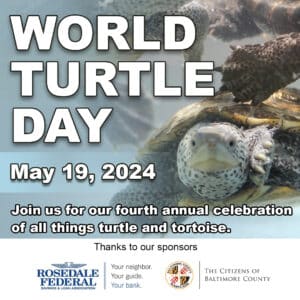Rarely is there an animal more beloved by humanity than the turtle. At World Turtle Day at the Natural History Society of Maryland, meet and interact with over a dozen species of turtles, learn about the latest conservation efforts, and see specimens from the NHSM collections. Engage in hands-on educational activities, play turtle games, make turtle crafts, dress in your finest turtle gear, and feed a giant tortoise.
World Turtle Day was created in 1990 as an annual observance to help people celebrate and protect these beloved creatures and their vanishing habitats around the world. There are 17 types of turtles that call Maryland home. Of those, 12 species are threatened by habitat loss and 9 are experiencing population decline. All four sea turtle species found in Maryland are protected by the ESA.
Please arrive during your selected time slot and head to the check in tent. There is no limit to how long you can stay, so enjoy your visit! Kids 3 and younger – FREE. Payment and Cancellation Policy: Payment is due online at the time of registration. Cancellations made seven or more days in advance of the event will receive a refund minus a 5% processing fee. Cancellations made within seven days of the event will not receive a refund. Events with fees of $10 or less are not refundable unless canceled by NHSM. NHSM retains the right to update or change these requirements at any time.
- 10:00 AM
- 11:00 AM
- 12:00 PM
- 1:00 PM
- 2:00 PM
World Turtle Day closes out with a presentation on restoration efforts for Maryland’s state reptile, the Diamond backed Terrapin from the guy who literally wrote the book on the subject, Dr. Willem Roosenburg. The talk is included in your ticket- we just ask that you RSVP is you plan to attend for planning purposes.
Poplar Island is a one-of-a-kind 1,140-acre restoration project off Tilghman Island in the Chesapeake Bay. Using dredge material from shipping channels, the island, which was reduced to but 5 acres in size is being reborn as a wildlife sanctuary. A lack of land predators, undisturbed sandy shorelines, and a variety of habitat types make Poplar an ideal terrapin nesting site
Since 2002, Dr. Willem Roosenburg, the director of the Ohio Center for Ecology and Evolutionary Studies and a professor of biological sciences at Ohio University, has been monitoring the diamondback terrapin population at Poplar Island, trying to better understand how terrapin populations are affected by the construction of the island and the quality of the habitat that results from the construction.
These terrapins are getting a head start, thanks to students across Maryland through the Terrapins in the Classroom project.

